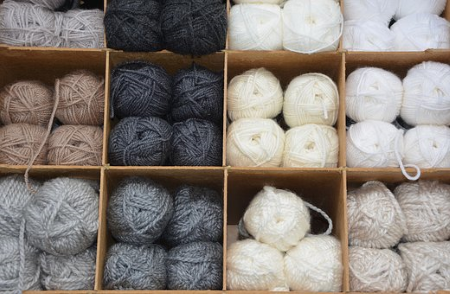 Although you can work on a broad range of knitting projects, blankets remain one of the most popular.
Although you can work on a broad range of knitting projects, blankets remain one of the most popular.
Whether knitting a blanket for a newborn baby as a welcoming gift, a throw blanket to snuggle up in while reading a book or watching a favorite movie, or even a full-sized blanket for your bed, you need to know the correct amount of wool yarn to purchase.
Especially if you plan to knit a blanket using multiple colors, it’s important to buy the right amount up front. The reason is that if you run out of yarn before completing the project, you might have a hard time matching the color. Remember, if you have extra yarn, you can always save it for another project.
Even if you have friends who have knitted blankets for years, it’s always better to do your own estimate. Not that they would steer you in the wrong direction, but this is an excellent way to learn how to buy the right amount of yarn for this and future projects. Before long, you’ll be a pro when it comes to purchasing wool.
For the sake of example, let’s say you want to knit a baby blanket. As you can imagine, there is an abundance of knitting patterns available or if you have a lot of experience with knitting, you might even come up with your own design using a basic stitch as the foundation. In fact, you could select a pattern for a full-size afghan and simply decrease the size to make an adorable baby blanket.
General Guidelines
As a general rule of thumb, the thicker the wool yarn the less amount you’ll need. After all, large stitches take up significantly more space, which means you can get by with less yarn, especially when working on smaller projects like a baby blanket. In comparison, if you plan to use intricate stitches, perhaps using lace-weight yarn, you’ll need to buy quite a bit more.
If you ultimately select a pattern, but you notice it calls for sport-weight yarn, remember that you won’t need as much wool as stated. In this case, you would simply adjust the required amount according to the project.
Something else to consider when buying yarn for a knitted blanket, or anything for that matter, is that usually, pattern makers base the yardage estimate on the Stockinette Stitch. Keeping that in mind, for a baby blanket with cables or a textured stitch pattern, you’ll need to purchase a lot more yarn than listed. On the other hand, if you plan to use larger knitting needles and lace stitches, you can get by with much less.
While this all might sound somewhat complicated, it’s actually quite easy once you get the hang of it. Even though knitted blanket patterns vary, you can follow some simple guidelines. For a baby blanket that measures approximately 36 inches in diameter, use the formula below.
Bulky Weight Wool – 900 yards
Worsted Weight Wool – 1,000 yards
Light Weight Wool – 1,100 yards
Sport Weight Yarn – 1,200 yards
Sock Weight Yarn – 1,300 yards
One final note. If you decide to use different yarn from what the pattern suggests, you’ll probably have to recalculate a little.
Use the number of yarn skeins required for the pattern times the yards per skein, which gives you the total yards of wool you need.
Use the total yards required for the pattern divided by the yards per skein of the yarn you selected. That equals the number of skeins you’ll need for the project. If necessary, round up to the nearest whole number.
PS – If you want to finish off your knitted project with something fancy, rhinestone buttons for clothing or craft rhinestone buttons might be the perfect accompaniment. Here’s a page I did on the different ideas and suggestions I could think off.
